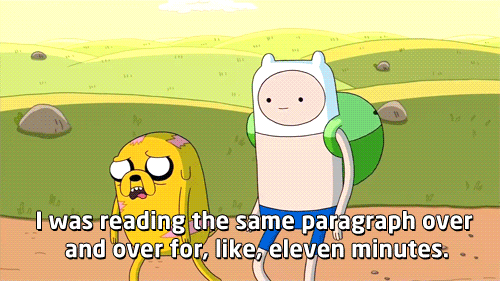10 Gifs Describing Your Back-to-School Feelings
Oh man! It’s time to go back to school! Unfortunately, time flies when you’re having fun. We get it, you want to chill and enjoy your vacation. Just to cheer you up Nerdify has compiled a bunch of awesome gifs, that will turn your frown upside down. Recognize yourself?
1. When you want to run away from homework and stress.

You can run, but you can’t hide!
2. When the teachers and lectures are boring…

Yeah! Sleeping in class for the win!
3. Mourning for the loss of your summer break be like…

You left without saying goodbye; I can’t live without you (Sure you can!).
4. That awesome feel when you see your close friend in school.

You are like long-lost lovers. Aww!
5. When you and your friend are in different classes this year.

So close, yet so far. What’s the point of education now?
6. Seeing your school crush (again) be like…

You can’t help but be inspired. You promise to do well in school and be with him/her for the rest of your life.
Then, you remember—the concept of forever does not exist.
7. You ask yourself, “When’s the next holiday or long weekend?”

When you’re stressed, you need to rest. There are even people who ask, “When’s the next storm or typhoon?” (That’s bad!)
8. When the teacher asks, “What did you learn from last school year?

How can we remember when it’s one of the things we least care about?
9. When your teacher calls your name for self-introductions.

You’ve never been so screwed in your whole life!
10. (Bonus!) When the school bells rings for lunch break/dismissal.

And you’re probably exhausted. Nevertheless, you try to muster a small smile. Looks like lunch and dismissal are going to be your favorite subjects again.
And remember that no matter how many tasks you have and how little time to complete them all, Nerdify is here for you 24/7. Our Nerds are always happy to help with every study-related task:)
-
August 9, 2018
Greetings, Nerdify fans! Imagine that you’ve been working on your resume for several hours, then sent it to different companies in the hoping to get an invitation for the interview. Finally, it happened, but you started panicking, as you don’t know what to do and how to behave.
Don’t be afraid! Follow Nerdify recommendations that will help you cope with stress and pass the interview successfully.
Before the interview:
1. Pick proper clothes
Good clothes open all doors. So try not to contradict the corporate style. Perhaps in the organization, they prefer to dress in casual. Then don’t stand out and don’t come in an office suit. Just from the doorway, you will be perceived as a stranger. Conversely, in areas where every employee must wear a suit, jeans and a sweater will look weird. Anyway, the clothes should be clean, ironed and neutral.
2. Explore the company
Most companies have websites where you can find all the information: from the history and the founders to the mission and contacts. Spend an hour or two on this site for a deeper study of the organization. Find out what qualities and skills the company values in employees and whether you have them. Knowledge is power, but it also shows that you are serious about it and you care about which company to work in.
3. Review your resume
You think that you already know your resume throughout and across but read it again, thinking about the possible questions of the employer. Try to correlate your answers with the position you are applying for.
4. Write an elevator pitch
Еlevator pitch is a short 30-second presentation of yourself, answering questions: ‘who are you?’, ‘what can you offer?’, ‘what contribution can you make to the company?’. It’s always difficult to write about your strengths and benefits, but you have to learn how to sell yourself as a professional.
5. Make a repetition
Invite a friend or family member to have a mini-interview with you. Tell them your elevator pitch. Ask them to ask you some typical questions, and you give them the best answers. You can also ask them for the feedback. Rehearsal interview allows you to get used to this process so that you feel comfortable and confident in a real interview.
6. Prepare questions on important topics
As you gather information about the company, write down the questions that arise. On some questions, you can find answers in the process of studying the company. The rest you can ask the interviewer. Don’t forget that the interview is primarily a dialogue. Moreover, interesting and reasonable questions characterize the applicant positively.
7. Prepare answers to typical questions
A good improvisation is a rehearsed improvisation. Prepare answers to potential questions whenever possible. Definitely, you will not define all the questions that you will be asked. And yet it does not prevent you from getting ready. Look at the lists of typical questions in the interview. Think about your answers. Most often, the interviewer will ask you the text of your resume: your last job, why you quit, etc.
Pronounce the prepared phrases aloud. Not everyone has an innate oratorical talent, so you should develop this skill at every opportunity. Especially before the interview.
During the interview:
1. Follow the posture
Sit straight, spread your shoulders, don’t bring your head down. Nothing in your behavior should say that you are a lazy student. You are not a lazy student and you don’t want the interviewer to accept you for who you really are not. So, don’t slouch!
2. Maintain eye contact
By maintaining eye contact with the interviewer, you demonstrate your sincerity and confidence.
3. Do not apologize for lack of experience
Instead, emphasize your education, skills, and strengths.
4. Answer questions honestly
Never lie. Even if some of the interviewer’s questions make you uncomfortable, don’t lie and never change the subject. You have to tell the truth, only the truth and nothing but the truth. This is what is appreciated the most at Nerdify.
5. Omit some details
No one needs to know the details of your background. The more you explain these or those situations, the more you create an impression of yourself as an exculpatory and protective person. As it was mentioned before, don’t lie, speak about the facts but omit the details. Hold confession for your therapy session.
6. Use a professional language
Even if the interviewer is being rude, don’t follow his example. Maintain a professional level, refraining from the tartness, inappropriate jokes. As a student, you can’t boast of extensive experience, but you are able to show your ambitions, fresh and new look and readiness to work.
After the interview:
Send a thank you note by e-mail to your interviewer within 24 hours after the end of the interview. Thank him for the time and confirm your interest in this work. The letter shouldn’t be too long and make sure that it doesn’t contain grammatical errors.
You are still a beginner in the labor market and it will be difficult for you to pass the interview right away. Hever, these recommendations from Nerdify will help you prepare for all the pitfalls that may meet you on the way to getting a job.
Good luck!
-
September 14, 2018
Hey there, pal! Without a doubt, you have many questions about college life! It reminds you of an ocean full of unknown and probably dangerous species. But no worries, cuz Nerdify is here to help!
Making it through your freshman year at college is like stepping on a way of the warrior – the secret is to learn how to fight for your rights as you learn, analyze, interact, become organized, and start to think strategically. No, the real trick is to have fun no matter what! Here are some helpful tips to guide you through the first year of college life without too much trouble, stress, and anxiety.
Getting Organized Is the Key!

You have read it right – you have to become organized no matter what as it is one of the most important skills that you should have in order to survive through college. It does not matter what your strong and weak sides are because you have to work on other issues. They are time management, learning all the due dates for important diverse events, keeping track of available funds, and so on. We have it summed up for you, so you know what parts of your life have to be under control:
1. Use organizers, smartphone applications or a big calendar on your wall to keep track of all the critical deadlines. It should not only be about college but about anything that is important in your life. Even birthdays, invitations, financial matters, family gatherings, and scheduled meetings with college professors.
2. Organize each task from the urgent to less urgent and less difficult to most difficult assignments. This allows you to manage your time and physical strength by starting with the most important tasks first while knowing what tasks can be easily completed to help you feel satisfied.
3. Create a budget for yourself, consult with your friends and family, so you can get a word of advice and see how you can feel financially secure.
Become a Jedi of Social Interaction.
You have to work really hard on your personality and place in the society as you enter college. It is not really difficult to become a Jedi of social interaction! No matter how complicated your studies may be, your strong social skills, charisma, warm smile or a friendly pat on the back will always do much more than you can imagine! So, what exactly has to be done? Okay, just follow this list:
1. Do not miss meetings with your professors. There are special scheduled hours that all professors have, so take advantage of each opportunity and speak of what makes you feel concerned.
2. Meet your academic adviser. This person is really important for your success and college progress, so getting to know him or her and becoming friends is critical. In case something does not work, remember that you can always ask for another academic adviser.
3. As a part of social interaction, get involved in all things campus: student organizations, clubs, voluntary work, all kinds of fraternities, if you would like. Start a band or become a part of a college sports team. You will not only make new friends and learn some amazing skills but will eventually feel connected and at home.
4. Build a network of friends, meet new people, and do not be afraid of taking mentoring roles to support and help other people.
Building a Bridge Between Studies and Times of Leisure.
One of the worst challenges a college warrior faces is fighting for the girl or a guy he or she has a crush on. No, seriously, it is quite an issue! Just be yourself and speak of your feelings! Unfortunately, romance is not the only problem you will face at college.
Okay, now another challenge is finding a right balance between the studies and times of leisure. Out of all things, find a cozy and calm place where you can study and concentrate. Next, study course syllabus more than twice and see when and what are your due dates, so you can plan that party without damaging your academic progress. College life is always balancing between your social life and study-related events, so the best thing you can do is make it 50/50. You have to study hard, so you can party hard!
As you strive for good grades, do not forget to use all the available study resources on campus. If there are learning labs and tutors, make sure that you use their help even if you think that you do not need it. After all, they have a purpose to be here… and that purpose is YOU! Still, if you do not think that it is an option, try to become a part of study groups, so you and your friends can schedule the same time for studies and leisure. This way you can find some peace and stop feeling like letting someone down!
Battle of Priorities

We are sure that you have heard it all before, but we will say it again that college life, especially the freshman year, is a battle of priorities where important things should come first. Okay, but what is important and how to understand what is really important? Yes, studying is necessary, but unlike most guides, we want to tell you that taking some time for yourself is just as important as academia! If you feel totally stressed, no high grades will be of any good. Even if it is your favorite television show, writing a journal, playing guitar or just riding a bicycle through the park, it is just as important!
All you have to do is to take full responsibility for what you choose and work on your priorities. Try to take one step at a time as you study and make a list of what tasks are closer to the deadline, what college assignments should be done as soon as possible to stop making your life a mess. Yet, at the same time, always ask yourself about what will make you feel best of all even in the middle of a Jedi battle with another complex subject!
Just remember that even if doing things the last minute before the lessons start could work in high school, it may not work in college. So, it is much safer to stick to deadlines and prioritize your time and resources. In other words, do not take shortcuts and do not cut corners as you progress. Do not cheat because it is your life. It surely deserves the best you can give!
When Things Just Won’t Work…

Trust us, we all have been in situations when things just won’t work and you feel like it is the end of the world! It is perfectly normal because you are in a different environment, you are away from home, so there come anxiety and homesickness among other things. Even if you always wanted to get away from home, college is not always what you have expected. There are three basic rules that you should remember to help you overcome sadness, stress, anxiety, and this feeling when you just do not want to be in college any longer.
1. Stay on campus as much as you can, so the more time you spend on campus, the more you will feel at home and as a part of a community. Join social and cultural events that take place to get your mind away. Try to be creative, have fun, joke around, and inspire people because, trust us, they feel bad too even if they do not show it!
2. Be ready to feel stressed, tired, and overwhelmed. Just know that you are not the only one feeling this way. Do not feel pressured to make hasty decisions about chosen career or a major. Give it some time, try to learn and see what it is. It is not a race that you have to win. Hence, see what you really enjoy, but take time to learn it inside out, talk to professors and other students before you make a turn.
3. Seek professional help when and IF you feel that you need it. It is perfectly normal. The colleges have counseling and health centers, so if you are not feeling well, you should let professionals know. Depression, bullying, feeling isolated, harassment or any conflicts should be reported, as you do not have to face these challenges alone.
We hope that all these little tricks and tips will help you to get through the freshman year at college. Be determined, take advantage of your social network of friends, voluntary work, and the special skills you definitely have. Have fun as you learn, give some time for yourself and remember that it is your life that you can control. You are already a warrior who is winning the first battle because you have what it takes!
Do not forget that you are studying to help yourself feel good about life and do not let any stress ruin it, just contact Nerdify for help any time.
-
October 31, 2018
If you’re looking for the best hobby for you as a college student, you’ve come to the right place. Nerdify reviews team wants to help turn your free time into an exciting and useful activity!
Which will be your pick? Will you choose to explore the world or let your creativity blossom? This blog post reveals the pros and cons of the most popular hobbies for college students and will help you make the right choice.
1. Geocaching
If you aren’t familiar with geocaching, it’s basically an outdoor hide-and-seek game using GPS. It’ll make you go to the places you’ve never been before, feel that treasure hunt rush, and have fresh air.
Pros
- Costs nothing, except maybe bus or train fare
- Will make you go outside
- You’ll feel like a treasure hunter
- Cool activity to do with friends and family
- Explore nature
- You’ll see your usual environment from a new perspective
Cons
- Easy to get sucked in, if that can be considered a con
Geocaching is fun and exciting, costs nearly nothing, and promotes physical activity – what’s not to love?
2. Blogging
If you have ideas to write about, thoughts you’d like to save forever, or just practice writing, start your own blog. Plus, your blog can become a part of your professional portfolio.
Pros
- Free
- No limitations – you do you
- Will help you improve your writing skills tremendously
- You’ll learn a lot along the way
- Can potentially help you build a career
- You can make a difference in any field
- You can make money from it
- Connect with new people
Cons
- Requires regular updates
- You can get into writer’s block
- Trolling can get in your way
If you start a blog, your writing will live on, that’s for sure. If you’re willing to invest time and effort in it, you’ll surely get the benefits described above.
3. Crafting and Artistry
This is an awesome talent that you should absolutely embrace in your free time. It absolutely doesn’t matter what you can do – knitting, crocheting, scrapbooking, cross-stitching, carving, drawing, painting, or DYI-ing things – all of it goes.
Pros
- Inexpensive
- You can let your imagination run wild
- You can create original, one-of-a-kind things
- You’ll always have awesome gifts to give to friends and family
- You can sell stuff and earn money from your awesome hobby (try Etsy)
- Whoever you tell about your hobby, will be in awe
Cons
- Requires patience
- Some materials can be up there in price
Make sure to take a moment to consider this great option!
4. Thrifting
There’s nothing more exciting than finding a cool item in a thrift store at a bargain price. Remember that one man’s junk is another man’s treasure!
Pros
- Value is usually way higher than the price
- You can find unique and valuable things
- Great way to find collectibles
- By thrifting, you are giving a second life to things, which is good for the environment
Cons
- Requires a lot of time
- Sometimes you’ll fail to find what you want, but don’t get discouraged.
Thrifting is a great idea however you look at it, so happy hunting!
5. Exercise
If you’re already exercising on the regular basis, hats off to you. If you don’t – consider making it your hobby because it’s right for pretty much anyone.
Pros
- Increase energy
- Look younger and feel better
- Overcome the negative effects of a sedentary lifestyle
- Maintain healthy weight
- Improve body strength and posture
Cons
- Depending on what you do, there’s risk of injury, so make sure you know what you’re doing
- If you choose to go to the gym, it can be expensive
You don’t need gym membership to go for a run every morning, so invest your time in yourself!
6. Playing an instrument
This is a hobby that always makes people go, “Wow!” when you tell about it. If you already can play an instrument, use your free time to perfect your skill. If not, you can spend your time learning how to play an instrument.
Pros
- It’s awesome and cool
- Makes you stand out
- Trains your brain
- Can become a source of income one day
Cons
- Instruments are expensive, but you’ll rarely have to buy a new instrument
If you play for your own enjoyment or want to finally learn to play an instrument, it’s the perfect time to start!
7. Photography
Being good at taking pictures is a great skill you’ll be able to use your whole life and you don’t need an expensive camera to be an awesome photographer.
Pros
- Experience pleasure in photography
- People will ask you to take pictures
- Keeping precious moments forever
- Requires no investment (who said you can’t use your smartphone camera?)
- Can become a career
Cons
- If you decide to invest in a camera and gear, be prepared to spend a lot
Photography is a beautiful hobby and requires only one thing – your passion.
8. Cooking
Cooking is an essential skill to have in life. We live in the world of processed foods that aren’t that great for us, so why not learn how to cook yourself?
Pros
- You’ll eat tasty foods
- People will praise your cooking skills
- You’ll learn how to save money on food
- You won’t want to return to McDonald’s ever again after making your own chicken nuggets
Cons
- Ingredients might be expensive depending on the recipe
Cooking is a great hobby to treat yourself, literally.
9. Urban exploration
You probably think you know the area you live in pretty well, but often there’s a lot more to discover. Exploring your environment is an exciting hobby that will become a source of never-ending topics to discuss with friends!
Pros
- Learn to find your bearings on the ground
- Find fun and interesting places to spend time
- Find what to share with friends and family
- Find great places to study (cafés, libraries, etc)
- Take lots of great pictures if you want to
Cons
- Might require some research
- Time-consuming
Become a tourist in your own city for one day – it might just be the coolest hobby you can find as a college student!
10. Origami
Most people who have tried origami, have probably tossed it after failing to fold a crane. If you’re a tough cookie, you’ll nail even the hardest tasks! P.S. We have a very passionate origami-fan in our Nerdify reviews team too!
Pros- Unique
- Easy to find tutorials
- Helps focus
- Entertaining
- Very low cost
Cons
- Might be frustrating when it gets too challenging
For a college student, origami is a cool hobby that is cheap and fun, so give it a try!
11. Learn about art
If some of the best places you’ve been to is the art museum, you might consider making learning about art your hobby. You can watch retro movies, learn about the history of fashion, or focus on specific periods in art history.
Pros
- Broadens your horizons
- Free
- Can make for a long-term hobby
Cons
- Isn’t a too relaxing hobby for a busy student
Make learning about what you love about your hobby!
12. Learn a new skill that pays
It’s always great to do what you love for money. You can learn how to do manicure, cut and style hair, do makeup, or carve wood. All these hobbies can help you earn money as a college student.
Pros
- You get to improve your skills
- You can earn from a hobby
Cons
- Requires having good skills, to begin with
Hobbies that pay are among the most popular hobbies for college students!
Whichever hobby you pick, remember that the best one will be the one that you are passionate about. Nerdify reviews team agrees on one thing: pick whatever puts a smile on your face and you’re golden!







